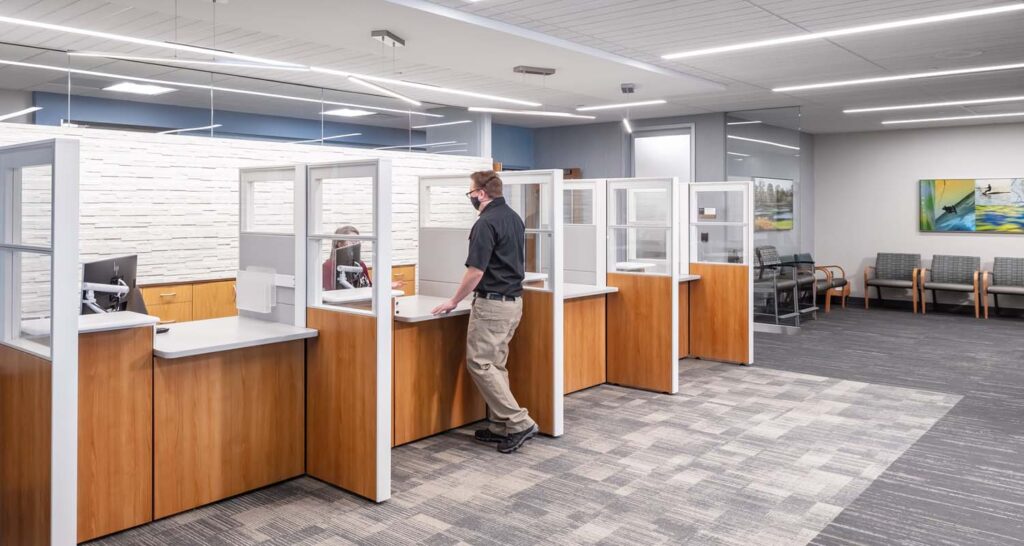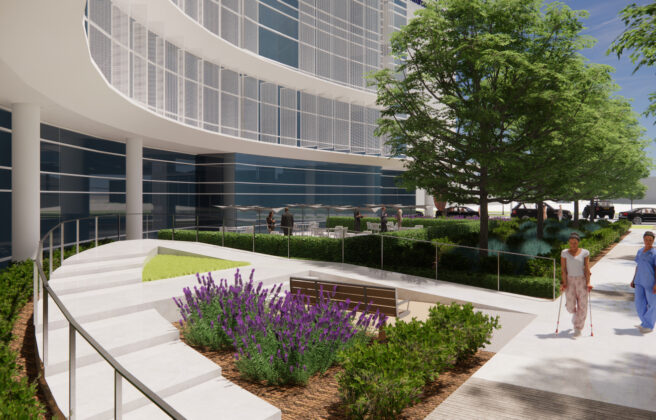No two health clinics are the same, all serving different populations and ranging vastly in size and function. With this in mind, designers and clinic staff have many considerations to make before launching into a renovation or new build. Here are some of the BWBR team’s thoughts on what goes into planning a clinic and some questions to consider throughout the design process.
Trends in Telehealth
Although healthcare has always been at the forefront of technology, the pandemic made telehealth more widespread in clinics — and in many cases, a necessity. Today, providers continue to conduct consultations and visits with patients remotely, increasing access to care for patients in rural areas, patients with limited physical mobility, patients without transportation, and more. Telehealth also provides the opportunity to connect with specialists located across the country. This means thinking through where providers will be making those calls.
Some clinics may opt to designate rooms with enhanced lighting and acoustics to optimize video and sound quality, ideally in a quiet area to avoid background noise. For other clinics, the best choice for maximizing space and budget is incorporating technology (like television screens) into exam rooms, making them multi-functional for both remote and in-person visits. Other providers might prefer to take telehealth calls in private focus rooms.
Enhancing Efficiency
The use of technology to facilitate the patient check-in process is another consideration for clinics, with some utilizing digital check-in kiosks. These kiosks are often used for self-rooming, allowing patients to receive automatic room assignments and direct themselves without staff assistance. Although kiosks may not be a fit for all clinics, some find they improve efficiency for both staff and patients while eliminating the need for large lobby areas. With this strategy, extra space can be utilized for additional exam rooms or staff areas.
If a traditional reception is preferred, it’s important to consider the choice between a centralized registration desk or departmental check-in stations. While a centralized registration can simplify the patient experience, departmental stations may be better suited for a busy or expanding clinic. Either way, thoughtful planning of the placement of high-traffic areas makes a big impact on wait times, organization, and overall efficiency.
Going With the Flow
Along with reception desks, the location and number of access points in a clinic keep foot traffic moving smoothly. Strategically planned, secure entrances and exits for patients and staff provide the foundation for security and streamlined flow.
A traditional clinic layout prioritizes provider privacy and creates a simple, one-way flow path for patients, making it seamless to move through the clinic. Although a connected floor plan reduces provider privacy, it allows for a mix of private and team staff workspaces and offers easier access to patient spaces. The best layout for a given clinic will vary based on facility size, patient volume, and preferred workflow of staff, and is why a design team who digs deep to understand the true needs and provide a custom solution is so important.
A Team Approach
A team-based care model has been appearing in select clinics, as patients oftentimes work with multiple healthcare professionals, particularly when specialized providers are involved. With a team-based model, these different providers communicate and collaborate with one another, but the specifics can vary widely among healthcare systems, as can the impact on their infrastructure. Clinics should consider how their teams currently work together and if opportunities for collaboration are wanted in the future.
These considerations will impact decisions like whether private provider offices are the best fit for the staff compared to shared, open offices. Other staff spaces, like team areas, meeting rooms, or individual focus rooms are also dependent on the function of teams in a clinic and what work style suits the staff best.
Space for Specialties
Doctors administering specialty care and procedures often require different tools and technology than those providing primary care. Because of this, it’s crucial to consider what types of treatment will be offered in a clinic, as rooms designated for specialties like ENT, OBGYN, or behavioral care may need extra space to fit unique equipment or optimize the patient experience. While an OBGYN exam room could benefit from a private bathroom, a room used for ENT may need a reclining chair rather than a traditional exam table. If rooms need to flex between uses day-to-day — or even hour-to-hour — storage capacity, space for equipment to move in and out, proximity to diagnostic or lab areas, and flexibility of furniture are all important considerations.
There’s certainly no one-size-fits-all solution when it comes to clinic design, but thinking ahead to what features make a clinic and its staff unique helps designers create a plan that reflects its needs.








